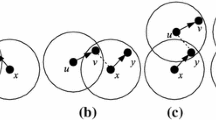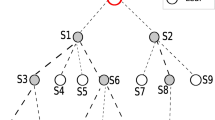Abstract
Emerging applications require processing a huge amount of environmental data from wireless sensor networks, and then triggering appropriate actions in response to the detected events. To this end, it is desirable to minimize the time needed for data aggregation. This paper investigates the minimum-latency aggregation scheduling problem in wireless sensor networks. We propose an aggregation tree construction algorithm called Break-and-Join which adjusts any aggregation tree toward a smaller delay one. In order to perform tree adjustments, the algorithm iteratively changes parent of some nodes in the tree, using a novel numerical metric as a tree quality guideline. Each node determines if it can adopt an additional child in the neighborhood in order to relax the aggregation load at some bottleneck node in the network, thereby improving the overall aggregation tree quality. We performed the algorithm on several state-of-the-art aggregation schemes, and the results shows that final aggregation delay is quite indifferent to choice of initial tree and the tree quality can be significantly improved (e.g. 7 times for shortest path tree). Scheduling on the obtained trees also outperforms the best known scheme up to 13% in terms of delay.












Similar content being viewed by others
References
Bagaa, M., et al. (2014). Data aggregation scheduling algorithms in wireless sensor networks: Solutions and challenges. IEEE Communications Surveys & Tutorials, 16.3, 1339–1368.
Ali, I., et al. (2018). Data collection in smart communities using sensor cloud: Recent advances, taxonomy, and future research directions. IEEE Communications Magazine, 56.7, 192–197.
Liu, A., Chen, Z., & Xiong, N. N. (2018). An adaptive virtual relaying set scheme for loss-and-delay sensitive WSNs. Information Sciences, 424, 118–136.
Akyildiz, I. F., et al. (2002). Wireless sensor networks: A survey. Computer Networks, 38.4, 393–422.
Gagnon, J., & Narayanan, L. (2015). Efficient scheduling for minimum latency aggregation in wireless sensor networks. In 2015 IEEE wireless communications and networking conference (WCNC). IEEE.
Luo, D., et al. (2011). Maximizing lifetime for the shortest path aggregation tree in wireless sensor networks. In Proceedings IEEE of INFOCOM, 2011. IEEE.
Wan, P.-J., et al. (2009) Minimum-latency aggregation scheduling in multihop wireless networks. In Proceedings of the tenth ACM international symposium on Mobile ad hoc networking and computing. ACM.
Tian, C., et al. (2011). Neither shortest path nor dominating set: Aggregation scheduling by greedy growing tree in multihop wireless sensor networks. IEEE Transactions on Vehicular Technology, 60.7, 3462–3472.
Chen, X., Hu, X., & Zhu, J. (2005). Minimum data aggregation time problem in wireless sensor networks. In International conference on mobile ad-hoc and sensor networks. Springer, Berlin.
Malhotra, B., Nikolaidis, I., & Nascimento, M. A. (2011). Aggregation convergecast scheduling in wireless sensor networks. Wireless Networks, 17(2), 319–335.
Pan, C., & Zhang, H. (2016). A time efficient aggregation convergecast scheduling algorithm for wireless sensor networks. Wireless Networks, 22(7), 2469–2483.
Huang, S. C,-H., et al. (2007). Nearly constant approximation for data aggregation scheduling in wireless sensor networks. 26th IEEE international conference on computer communications, INFOCOM 2007. IEEE.
Yu, B., Li, J., & Li, Y. (2009). Distributed data aggregation scheduling in wireless sensor networks. In INFOCOM 2009. IEEE.
Wan, P.-J., Alzoubi, K. M. & Frieder, O. (2002). Distributed construction of connected dominating set in wireless ad hoc networks. Proceedings of twenty-first annual joint conference of the IEEE computer and communications societies, INFOCOM 2002 (Vol. 3). IEEE.
Li, Y., Guo, L. & Prasad, S. K. (2010). An energy-efficient distributed algorithm for minimum-latency aggregation scheduling in wireless sensor networks. In 2010 IEEE 30th international conference on distributed computing systems (ICDCS). IEEE.
Xu, X. H., et al. (2011). A delay-efficient algorithm for data aggregation in multihop wireless sensor networks. IEEE Transactions on Parallel and Distributed Systems, 22.1.1, 163–175.
Jakob, M., & Nikolaidis, I. (2016). A top-down aggregation convergecast schedule construction. In 2016 9th IFIP wireless and mobile networking conference (WMNC). IEEE.
Fasolo, E., et al. (2007). In-network aggregation techniques for wireless sensor networks: A survey. IEEE Wireless Communications, 14(2), 70–87.
Incel, O. D., et al. (2012). Fast data collection in tree-based wireless sensor networks. IEEE Transactions on Mobile computing, 11.1, 86–99.
Kang, B., et al. (2017). A distributed delay-efficient data aggregation scheduling for duty-cycled WSNs. IEEE Sensors Journal, 17.11, 3422–3437.
Ye, W., Heidemann, J., & Estrin, D. (2002). An energy-efficient MAC protocol for wireless sensor networks. In Proceedings of twenty-first annual joint conference of the IEEE computer and communications societies, INFOCOM 2002 (Vol. 3). IEEE.
Hariharan, S., & Shroff, N. B. (2011). Deadline constrained scheduling for data aggregation in unreliable sensor networks. In 2011 international symposium on modeling and optimization in mobile, ad hoc and wireless networks (WiOpt). IEEE.
Cho, H., Kim, J., & Baek, Y. (2011). Enhanced precision time synchronization for wireless sensor networks. Sensors, 11(8), 7625–7643.
Erzin, A., & Pyatkin, A. (2016). Convergecast scheduling problem in case of given aggregation tree: The complexity status and some special cases. 2016 10th international symposium on communication systems, networks and digital signal processing (CSNDSP). IEEE.
Plotnikov, R., Erzin, A., & Zalyubovskiy, V. (2020). GLS and VNS based heuristics for conflict-free minimum-latency aggregation scheduling in WSN. Optimization Methods and Software. https://doi.org/10.1080/10556788.2019.1710836.
Acknowledgements
This work was partly supported by Institute of Information & Communications Technology Planning & Evaluation (IITP) grant funded by the Korea government (MSIT) (No. 2019-0-00421, Artificial Intelligence Graduate School Program (Sungkyunkwan University)) and Grant funded under GITRC support program (IITP-2020-2015-0-00742), and also supported by the National Research Foundation of Korea (NRF-2020R1A2C2008447).
Author information
Authors and Affiliations
Corresponding author
Additional information
Publisher's Note
Springer Nature remains neutral with regard to jurisdictional claims in published maps and institutional affiliations.
Rights and permissions
About this article
Cite this article
Nguyen, TD., Zalyubovskiy, V., Le, DT. et al. Break-and-join tree construction for latency-aware data aggregation in wireless sensor networks. Wireless Netw 26, 5255–5269 (2020). https://doi.org/10.1007/s11276-020-02389-x
Published:
Issue Date:
DOI: https://doi.org/10.1007/s11276-020-02389-x




